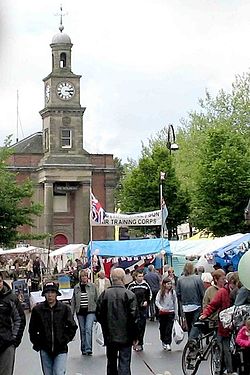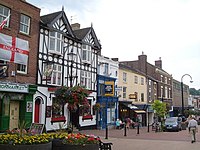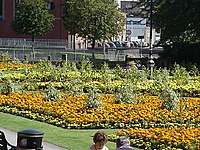Newcastle-under-Lyme
| Newcastle-under-Lyme | |
| Staffordshire | |
|---|---|
 The Guildhall, Newcastle-under-Lyme | |
| Location | |
| Grid reference: | SJ848459 |
| Location: | 53°-0’39"N, 2°13’40"W |
| Data | |
| Population: | 73,944 |
| Post town: | Newcastle |
| Postcode: | ST5 |
| Dialling code: | 01782 |
| Local Government | |
| Council: | Newcastle-under-Lyme |
| Parliamentary constituency: |
Newcastle-under-Lyme |
Newcastle-under-Lyme is a market town in Staffordshire. It is adjacent to The Potteries, the Staffordshire towns which became the City of Stoke on Trent. It is an old market town.[1]
Situated in a valley alongside the Lyme Brook, the town is immediately west of the neighbouring city of Stoke-on-Trent, its suburbs running into those of the city. Newcastle town centre is just 2 miles from Stoke-upon-Trent and less than 4 miles from Hanley, Staffordshire. Newcastle-under-Lyme is about 17 miles north of the county town, Stafford.
Contents
Name
The Newcastle part of the name derives from being the location of a 'new' castle, built in the 12th century.[2] The "Lyme" section could refer to the Lyme Brook or the extensive Forest of Lyme that covered the area with lime trees in the mediæval periodThis is Newcastle-Under-Lyme Newcastle is named after a 'new castle' that was built in the area in the twelfth century. The 'lyme' part of the name derives either from the Lyme Brook that flows through the town or from the lime forest that covered a large part of land in the mediæval period..[2][3]
History
1100s-1800s
Newcastle is not mentioned in the Domesday Book, as it grew up around the 12th century castle, but it must early have become a place of importance, for a charter, known only through a reference in a charter to Preston, was given to the town by Henry II of England in 1173. The new castle was built to supersede an older fortress at Chesterton about two miles to the north, the ruins of which were to be seen up to the end of the 16th century.
In 1235 Henry III constituted it a free borough, granting a guild merchant and other privileges.[2] In 1251 he leased it at fee-farm to the burgesses. In 1265 Newcastle was granted by the Crown to Simon de Montfort, and subsequently to Edmund Crouchback, through whom it passed to Henry IV. In John Leland's time the castle had disappeared "save one great Toure".
The Civil War largely passed the town by, apart from a plundering raid by a Royalist force.[1] However, it was the hometown of Major Thomas Harrison a Cromwellian army officer and leader of the fanatical Fifth Monarchy Men.
Newcastle was one of the first towns on the canal network. The canal, running from the Trent and Mersey Canal at Stoke-on-Trent to Sir Nigel Gresley's Canal has been disused since 1935 and most of it filled in.
The governing charter in 1835[2][4] which created the Newcastle-under-Lyme Municipal Borough absorbed the previous borough created through the charters of 1590 and 1664, under which the title of the corporation, was the "mayor, bailiffs and burgesses of Newcastle-under-Lyme."[2]
Twentieth century
When Stoke-on-Trent was formed by the 1910 amalgamation of the "six towns" (Stoke-upon-Trent, Hanley, Fenton, Longton, Burslem and Tunstall) Newcastle remained separate. Despite its close proximity, it was not directly involved in the pottery industry, and it strongly opposed attempts to add it in 1930[5] with a postcard poll showing residents opposing it by a majority of 97.4%. Although passed by the House of Commons, it was rejected by the House of Lords.[1]
The pottery industry was strong in Newcastle until the latter part of the twentieth century. When the factories closed the town sank into decline and unemployment.
Economy
Like neighbouring Stoke-on-Trent, Newcastle's early economy was based around hatting trade, silk and cotton mills. Later coal mining, brick manufacture, iron casting and engineering rose to prominence.[2] Very fine red earthenware and also soft-paste porcelain tableware (the first such production in Staffordshire) was produced in Newcastle at Samuel Bell's factory in Lower Street between 1724 and 1754 when all production ceased. With the exception of a failed enterprise between 1790 and 1797, which then switched to brewing, there was no further commercial production of pottery within the town of Newcastle. production of earthenware tiles however continued at several locations within the borough. Manufacture of fine bone china was re-established in the borough in 1963 by Mayfair Pottery at Chesterton.
The manufacture in the borough of clay tobacco smoking pipes started about 1637 and grew rapidly and was second only to hatting within the borough. Nationally, the town was ranked with Chester, York and Kingston upon Hull as the four major pipe producers. This industry continued until the mid-19th century when decline set in rapidly and by 1881 only one tobacco pipe maker was left.
In the 17th, 18th and 19th centuries the town had a flourishing felt hat manufacturing industry,[2] which was probably at its peak locally in the 1820s when a third of the town's population were involved in the industry in over 20 factories but by 1892 there was only one manufacturer still in production in the town.
In 1944, the Rolls-Royce Derwent engine for the Gloster Meteor fighter was made in the borough.
Economy
Newcastle's 20th century industries include: iron working, construction materials, clothing (especially military, police and transport uniforms), computers, publishing, electric motors, and machinery.
Near the turn of 21st century, the town received a major redevelopment to incorporate a new street (Castle Walk) in to the town centre, providing Newcastle with a new bus station and bringing in more companies.
A large number of pubs, clubs and bars provides Newcastle with a relatively strong nightlife, with students' night being on Wednesdays; this aspect of Newcastle has arguably eclipsed the shopping and market town it once was.
Sites of the town
Parks and gardens
Newcastle excels in the Royal Horticultural Society Britain in Bloom competition. In 2005 it was the national winner in the 'small city/large town' category (35K-100K).[6] The town features several parks including the Queen's Gardens, at the eastern end of Ironmarket, was awarded the Britain in Bloom Judges' Award for Horticultural Excellence in 2003[7] and is the only park within the ring road. Grosvenor Gardens in the centre of one of the town's roundabouts, hidden away below road level. The Queen Elizabeth Garden is located outside the town centre and is to undergo refurbishment using National Lottery Heritage Fund money.[8]
To the north west of the town centre is Brampton Park, home to the museum and art gallery.[9]
Traditional market
Dating back to 1173 Newcastle's market, known as The Stones, operates on the High Street.[10] The market was originally held on Sunday; in the reign of King John it was changed to Saturday; by the charter of Queen Elizabeth it was fixed on Monday. Grants of fairs were given by Edward I, Edward III and Henry VI. Today the market is open six days a week, and there are over 80 stalls. Mondays, Wednesdays, Fridays and Saturdays see a general market, on Tuesdays there is an antiques market and Thursdays are for the sale of bric-a-brac.
A cattle and livestock market was held on Mondays until the early 1990s; the site of the cattle market is now a branch of Morrison's supermarket.
Sport
- Football: Newcastle Town FC
- Cricket: Newcastle & Hartshill Cricket Club
- Rugby: Newcastle Rugby Union Football Club
Churches
The town has a long religious history. It was the birthplace of John James Blunt, a divine and Anglican priest.
The town itself has a large number of Anglican churches including St. Giles' Church, the mediæval parish church dating from 1290.
In the 18th century John Wesley made repeated visits to the area,[11] which was becoming more industrialised. He recruited many residents to Methodism. This is reflected in the large number of Methodist churches. The largest Baptist church in North Staffordshire is in Newcastle.
Outside links
- BBC Staffordshire website
- The Potteries
- Local Information from The Sentinel newspaper
- Staffordshire and Stoke-on-Trent Archive Service
- Fine Art Photographs of Newcastle Town Centre all taken on 20 April 2008.
- Newcastle Rugby Club
References
- ↑ 1.0 1.1 1.2 Newcastle-under-Lyme: University of London & History of Parliament Trust
- ↑ 2.0 2.1 2.2 2.3 2.4 2.5 2.6 "History of Newcastle". Newcastle-under-Lyme Borough Council. http://www.newcastle-staffs.gov.uk/leisure_content.asp?id=-A78083C8&cat=1263. Retrieved 2009-01-20.
- ↑ Ekwall, Eilert (1940). The Concise Dictionary of English Place-names; 2nd ed.. Oxford: Clarendon Press. p. 294.
- ↑ "Relationships / unit history of Newcastle under Lyme". A Vision of Britain. University of Portsmouth Department of Geography. http://www.visionofbritain.org.uk/relationships.jsp?u_id=10002795&c_id=10001043. Retrieved 2007-05-06.
- ↑ "Stoke-on-Trent Bill: Extension of the City". The Times. 02 May 1930.
- ↑ "2005 winners". Britain in Bloom. Royal Horticultural Society. http://www.rhs.org.uk/britaininbloom/heart_of_england/newcastlewinner2005.asp. Retrieved 2007-05-06.
- ↑ "Britain in Bloom". Newcastle-under-Lyme Borough Council. http://www.newcastle-staffs.gov.uk/General.asp?id=SXFBE1-A77F7BB2&cat=325. Retrieved 2007-05-06.
- ↑ "Lottery cash to restore town park". BBC News. 11 March 2007. http://news.bbc.co.uk/1/hi/england/staffordshire/6439721.stm. Retrieved 2007-05-06.
- ↑ "Borough Museum & Art Gallery, Newcastle". BBC Stoke. http://www.bbc.co.uk/stoke/culture/venues/a_f/borough_museum.shtml. Retrieved 2007-05-06.
- ↑ "Markets and Town Centres Information". Newcastle-under-Lyme Borough Council. http://www.newcastle-staffs.gov.uk/general.asp?id=-A77F7A70. Retrieved 2007-05-06.
- ↑ "The Christian History of Stoke-on-Trent". http://www.thepotteries.org/history/spiritual_history.html. Retrieved 2007-05-06.
Books
- Jenkins, J G (1983). A History of Newcastle-under-Lyme. Staffordshire County Library.
- Briggs, J (1973). Newcastle-under-Lyme, 1173-1973. Newcastle-under-Lyme Borough Council. ISBN 978-0-9502745-1-5.
- Morris, Dennis; Anthony Priestley, Joy Priestley, Roger Simmons, Edward Watkin (1987). The Borough of Newcastle-under-Lyme : A Portrait in Old Picture Postcards. Brampton Publications. ASIN B000IBSQAW.
- Adams, D W (1988). Wartime Newcastle-under-Lyme. Hendon Publishing Co Ltd. ISBN 978-0-86067-113-8.
- Adams, D W (1986). Newcastle-under-Lyme as it was. Hendon Publishing Co Ltd. ISBN 978-0-86067-106-0.

